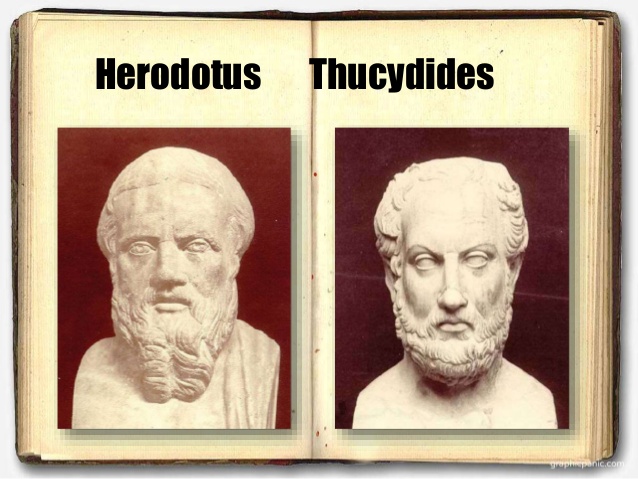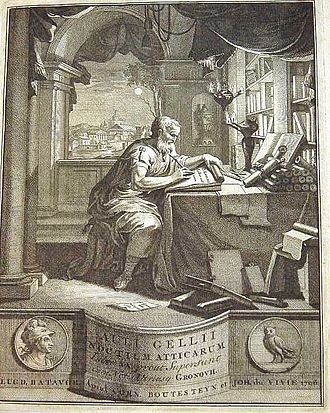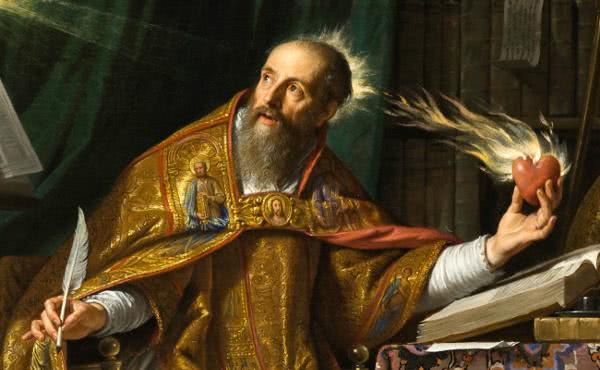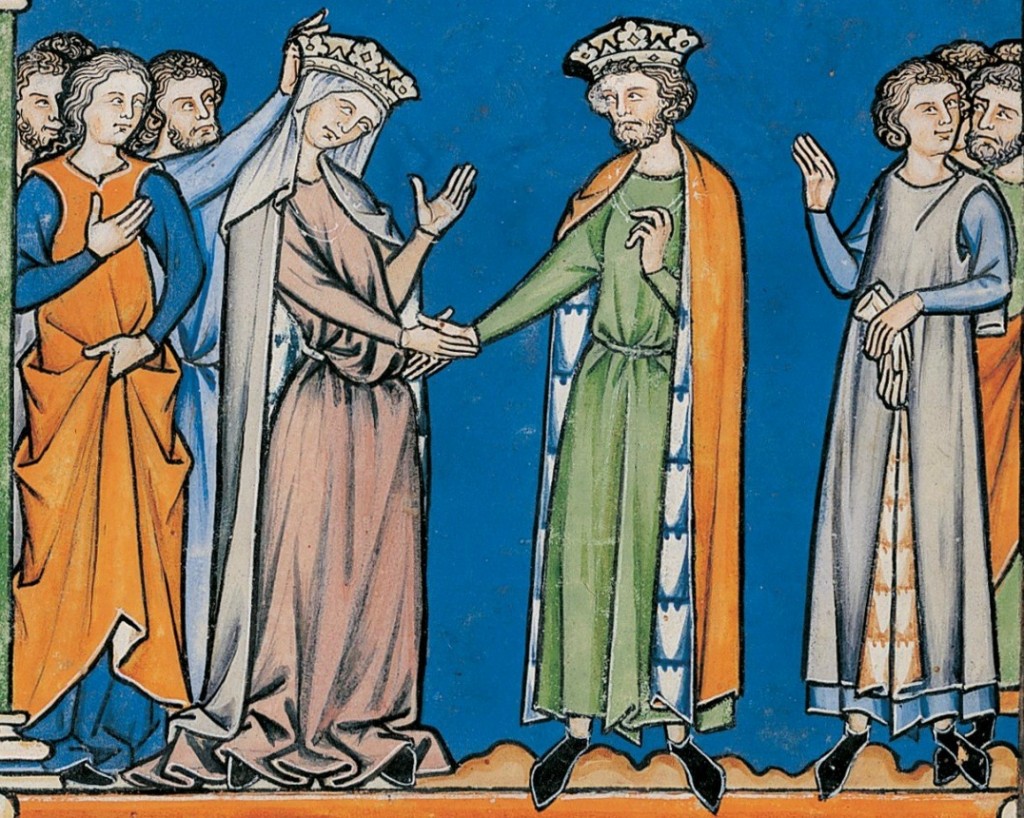Historical Truth
Defining Truth from Antiquity to the Enlightenment
By Kyle Chicharello
Historians have always searched for truth, but what constitutes the “truth” has changed significantly, and historians have been instrumental in that change.
The Greeks: Truth & Impartiality

The ancient Greeks are seen as the fathers of history and two Greeks stand out: Herodotus, and Thucydides, laid the foundations of history. These two men began to look at sources in a more critical way, and differentiated between what we would call primary and secondary sources. For Herodotus, the father of history, “history depended on the one of two criteria, that is to be based on testimony that was either eyewitness (opsis) or hearsay (akoe)” (Kelly, 21). Thucydides didn’t concern himself with hearsay (secondary source) and was our founder of a more political history, which would become a key part of historiography later. (Kelly, 29) Thucydides relied on telling the story of states in conflict and was more critical in his telling of history than Herodotus. Also during this period western civilization still relied on the myth-histories of Homer and other Greek poets to lay the foundations of creation, in the eyes of the Greeks. Ironically the Greeks were both critical of the events of the past, and yet relied on the myths of their ancestors to begin their stories of history.
The core principle that the Greeks passed down was their obsession with finding truth in sources. For Herodotus and Thucydides, “They wanted to tell the “truth” as they saw it and thus to communicate something of value to their readers”. (Kelly 42) These men inspired another Greek historian, Polybius, who said that “to be a good historian, however, involved more than just being a good man or a good citizen, for it required that he be prepared to tell the truth at all costs, to the extent of accusing a friend or praising an enemy.” (Kelly, 33) This obsession with truth is the fundamental principle that they gave us historiography.
The Romans: Truth, Criticism, Critical Understanding, & Rhetoric

To understand ancient Rome requires a deep sense of tradition that Romans believed in. This sense of tradition came from a great respect for the ancestors of Rome. The antiquarians (one who studies or collects antiques) and jurists (expert writer) investigated the relics of “bygone and often forgotten ages”. (Kelly, 49) This look into origins comes with a problem for the scholar Aulus Gellius, namely what is “the precise meaning of ancient words and their correct etymologies” (Understanding). (Kelly, 51) This is a key problem that modern historians have and even for Romans in the “ancient” world understanding was an issue “for long lapse of time has rendered old words and customs obsolete”. (Kelly, 51) Without understanding your sources historian cannot do “true history” as the Roman, Sempronius Asellio, said “one should also show with what purpose and for what reason things were done”. (Kelly, 52) Even in ancient times they knew the importance of truly understanding your sources and their intentions.
The ancient Romans created key concepts for defining “truth” by solidifying their belief in historical facts and by criticizing one another’s historical writings. Tacitus is by far the most trusted Roman historian because he told “no story to excite wonder; I do but relate what I have heard and what our fathers recorded”. (Kelly, 63) This regard for reporting the facts rather than telling a story was part of Tacitus’ “sharper analytical instrument, not the byways of Herodotean cultural history, but rather the Thucydidean model of mainly contemporary politico-military or “pragmatic” history”. (Kelly, 63) However more “truthful” reporting of facts was, “none of these historians were “objective” in a modern sense; all were eager to celebrate the moral virtues which had made Rome great”. (Kelly, 65) One of those historians, Cicero, is crucial to our methodology of truth within historiography, with his two laws regarding historical writing. The first law states: “that an author must not dare to tell anything but the truth”. (Kelly, 66) The second law states: “that he must make bold to tell the whole truth”. These two laws of Cicero led to an understanding that the “standard of truth was also what distinguished history from its sister art, poetry”. (Kelly, 66) These two laws created formal historical writing, requiring:
- Chronological arrangement
- Geographical context
- Consideration of the causes and consequences of actions
- Consideration for the portrayal of actors
- All the above must be done in a smooth narrative
According to the Roman Quintilian history was the third of three different forms of narrative, the other two being fiction and realism. This historical narrative, “which is an exposition of actual fact” according to Quintilian, has its formal institutional beginnings in ancient Rome. (Kelly, 67) If a historian didn’t adequately have a formal structure that emphasized truth then they were criticized by their contemporaries. Livy, a Roman historian famed for his rhetoric, was not considered true enough for Quintilian because “Livy for instance is frequently in doubt as to what actually occurred”. (Kelly, 68) In ancient Rome we have our first instance of the “practice of historical criticism and exposure of myth, usually associated with philology and pure scholarship”, because of the Romans’ belief in the role of rhetoric and truth in historical writing. (Kelly, 68) However, Truth had not yet become the center of historiograhpy because in ancient Rome it was that “truth remained a formal requirement… but effective communication to a sophisticated readership was the dominant consideration (rhetoric)”. (Kelly, 69) With the ancient Romans we have the beginning of a formal institution of truth within Historiography and the formal requirements regarding historical writing.
The Christians: Truth’s Subordination
After the legalistic tradition of Rome the role of Truth changes drastically during the Christian dominated transition period from Imperial Rome to the Middle Ages. The role of the historian also changed during this period, with their purpose being “to find the higher spiritual meaning which lay behind the letter of the human record”. (Kelly, 75) The historian Josephus, who lived in Imperial Rome, considered himself to be “devoted to the truth as he was to his nation, and he “insisted on the extreme antiquity” of Israel. (Kelly, 78,79) He begins a long tradition of Christian historians relying on sheer age or “tradition” to be the foundation of deciding truth. Josephus emphasized a type of universal history that would solidify this tradition of understanding truth, by arguing:
- The antiquity of Israel being farther back than Egypt or Babylon, and this sheer age being grounds for superiority and/or having God’s favor.
- Josephus was an ally of truth, and he understand the world through the lens of his Jewish perspective, while denying classical tradition.
- Due to the role of the Holy Scriptures of Israel, Josephus privileged the making and preservation of written records.
Another founding principle of Christian authors was the belief that “truth is in the word of God, which must be obeyed on the grounds of authority”. (Kelly 81) The historian Clement, believed in this principle and took it farther. He argued, “without the light of the Gospel, however, “Human traditions [are] intellectual nonsense”, and he believed in the “unified truth of Christianity”. (Kelly, 82) These principles pushed the classical form of truth below that of the Christian interpretation of truth because many Christian authors believed “Christian history was the expression of a higher truth”. (Kelly, 83)

This continued with the celebrated Christian historian and theologian, Augustine of Hippo, because his “conversion drew him away from the sectarian search for wisdom to the stable truth of the Gospel”. (Kelly, 91) Augustine justified this belief by stating that “history itself is not … among human institutions.”, and that “for events which have already occurred and cannot be undone are to be considered as part of world order, whose found and ruler is God.” (Kelly, 95) This was considered the higher spiritual meaning of history and “secular history, is a written form of human memory, and perhaps even more fallible”. (Kelly, 95) Also, “history represents a level of reading that corresponds to human language in its grammatical sense”. (Kelly, 95)
These two principles would be seen in the debate within Christianity between the letter and spirit of the law. For Christians the problem lies in the interpretation of written texts whether secular or spiritual. The interpretation of written texts eventually leads to the consensus that “the letter of the old law was the way of death, and only the spirit offered life.” (Kelly, 96) Repeatedly history is “occupying at once the lowest and the most fundamental level(s)”, and this low regard of history will be seen again in the later Middle Ages. (Kelly, 97)
The Barbarians: Secularism’s Foundation
The Early Middle Ages are more important for historiography than one would think. Other than medieval historians attempts to save the manuscripts of the past they laid the foundations of what would one day become secular historiography. Although the origins of the barbarian nations of Europe were based in myth, they were the beginnings of secular history antithetical to the universal religious history taught by the Catholic Church. This foundation for secular history was created by history being consider more practical and having “to do with rhetoric and liberal arts (rather) than the higher forms of knowledge such as philosophy and theology”. (Kelly, 100) This subordinate role of history may have been its’ salvation because the Christian church wouldn’t have seen the temporal role of history as a threat to divine Church doctrine. For these first “secular” historians, they regarded “history as a major force in the drive toward a truth that was divine as well as human”, and this truth value for these historians lied in their wanting to understand “the larger world of God’s creation”. (Kelly 101)
Also in Europe, during the Early Middle Ages we begin to see the start of a distinction between chroniclers, compilers of facts and data, and the historian, the one whom finds the meaning behind historical events. (Kelly, 103) Chroniclers, tell us what happened; historians tell us why it happened and why it mattered. We also begin to see the end of myth-histories near the end of this period with the criticism and rejection of the mythical tales of King Arthur. The tales of King Arthur were made historical by Geoffrey of Monmouth but were immediately assailed by his contemporary historians, and his work was label as fiction. (Kelly, 113) This is the foundations for scholarship as we know it in the west and historians became more critical of one another’s work. Although this scholarship still lacked a formal academic discipline, these actions by medieval historians laid the foundations of scholarship for later renaissance and enlightenment historians. The medieval age may not have been the most stable or prosperous, but its’ historians aided historiography immensely.

The Renaissance: Humanistic Historiography & Secularism’s rise
The Renaissance was especially important to historiography. It began the break between secularism and religion, which would directly lead into the challenging of traditions through the Reformation and the Enlightenment. The Renaissance lead to: revealing of forgeries,
Within this period we begin to see a stronger criticism of ancient sources and even as the Renaissance historians praised the ancients. They also criticized their work to the point of discovering forgeries. One example is the historical criticism work of the historian Petrarch on the Caesar grant for Austria. (Kelly, 133) Petrarch used historical ideas to reveal the ancient grant that exempted Austria from imperial jurisdiction as a forgery. This work to reveal forgeries became widespread during the Renaissance and illustrates the increased criticism towards the ancients of Rome and Greece.
The Italian city-states during the Renaissance were not only pioneers of art and science, but they contributed greatly to historiography. One italian historian, Bruni, displays Renaissance historiographical method rather well. In his chronicle of the city-state of Florence, he employed: Ciceronian laws of truth, a structured explanatory narrative, and only documentary sources of the “known history of Florence” by rejecting mythical foundations. His chronicle was also an example of the new humanist wave of historiography sweeping through Italy and a critical humanistic historiography would be continued by future Italian chroniclers.
The Reformation
During the reformation movement a battle occurred between protestant and catholic historiographers. The main point of conflict was which of the two branches of christianity were more “traditional”, by having closer roots to the first christians. The role of tradition was of paramount importance to both sides of the Christian reform movement,and history allowed for each side to attempt to legitimize their argument. (Kelly, 172) For the Catholic historiographer, Casare Baronio, his chosen form was annals because it allowed for a writing that was within the rigid requirements demanded by truth. However, the arguments presented by Baronio were quickly rejected by reformist historiographers, and the debate continued into the next few centuries. (Kelly, 173)
Also during this period, the old medieval myths of Trojan origins and Carolingian creation were dismantled by historiographers during this period. (Kelly, 179) In the place of these medieval myths arose new modern myths of nationalistic foundations. (Kelly, 181) In England during this period, the historian William Camden used a critical and impartial method to analyze the causes of historical events. (Kelly, 184) Other English historians during this period used historical scholarship and criticism to help recreate the English past. This period may not be filled with great sweeping changes of the medieval or renaissance period in terms of historiography, but it helped push along historiography into becoming an academic discipline.
Secularism: The Enlightenment
The key event for historiography in regards to truth was the Enlightenment. The Enlightenment created a formal methodology that allowed for more impartiality and Ciceronian truth to be found in historical writings. (Kelly, 190) The key to this is the amount of source criticism that was being used by the historians of the Enlightenment. They worked to reveal forgeries of the past, consulted many authors of the past on a particular subject, and began to create a formal methodology aimed towards universals rather than particulars. (Kelly, 193)
The secularization and codification of history were critical to the creation of an academic discipline that would become academic history. (Kelly, 198) To codify history is to know “not only what is said, but also by whom it is said, with what words it is said, in what time, on what occasion, what precedes, and what follows”. (Kelly, 205) This codification would be critical to the methodology of history, since reliance on credible sources is essential. The secularization of history is what allowed history to finally become a real academic discipline. The removal of church influence allowed history to be more impartial and search for a truth that could contradict the teachings of the Church.
.jpg
)
With these pillars of history being raised we can finally get to the scholarship that was also key to history becoming an academic discipline. The Republic of Letters, a network of correspondence between scholars, began a more comprehensive discussion between historians of different educational traditions. This “republic” is what allowed for discussion between Italians, French, German, and British historians, which began the academic discipline. Their work towards a truer academic discipline is what eventually led to historiography as we know it today.
Bibliography
Donald R. Kelly, Faces of History: From Herodotus to Herder Yale University Press, 1998.
Murray G. Murphy, Truth and History Albany, NY: SUNY Press, 2008.
Oscar Handlin, Truth in History Cambridge, MA: Belknap of Harvard UP, 1981.
Henri Marrou, The Meaning of History Baltimore, MD: Helicon Press, 1966.